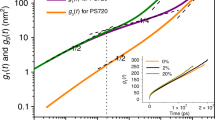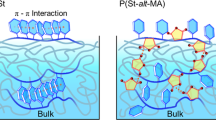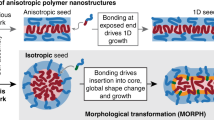Abstract
Nanoparticles have been shown to influence mechanical properties; however, transport properties such as viscosity have not been adequately studied. This might be due to the common observation that particle addition to liquids produces an increase in viscosity, even in polymeric liquids, as predicted by Einstein nearly a century ago. But confinement and surface effects provided by nanoparticles have been shown to produce conformational changes to polymer molecules, so it is expected that nanoparticles will affect the macroscopic viscosity. To minimize extraneous enthalpic or other effects, we blended organic nanoparticles, synthesized by intramolecular crosslinking of single polystyrene chains, with linear polystyrene macromolecules. Remarkably, the blend viscosity was found to decrease and scale with the change in free volume introduced by the nanoparticles and not with the decrease in entanglement. Indeed, the entanglements did not seem to be affected at all, suggesting unusual polymer dynamics.
This is a preview of subscription content, access via your institution
Access options
Subscribe to this journal
Receive 12 print issues and online access
$259.00 per year
only $21.58 per issue
Buy this article
- Purchase on Springer Link
- Instant access to full article PDF
Prices may be subject to local taxes which are calculated during checkout





Similar content being viewed by others
References
Einstein, A. On the theory of Brownian movement. Ann. Phys. (Leipz.) 19, 371–381 (1906).
VanDerWerff, J.C. & de Kruif, C.G. Hard-sphere colloidal dispersions: the scaling of rheological properties with particle size, volume fraction, and shear rate. J. Rheol. 33, 421–454 (1989).
Russel, W.B., Saville, D.A. & Schowalter, W.R. Colloidal Dispersions (Cambridge Univ. Press, 1989).
Metzner, A.B. Rheology of suspensions in polymeric liquids. J. Rheol. 29, 739–775 (1985).
Krishnamoorti, R., Ren, J. & Silva, A.S. Shear response of layered silicate nanocomposites. J. Chem. Phys. 114, 4968–4973 (2001).
Siegel, R.W. Exploring mesoscopia: the bold new world of nanostructures. Phys. Today 46 (October), 64–68 (1993).
Mayo, M.J., Siegel, R.W., Narayanasamy, A. & Nix, W.D. Mechanical properties of nanophase TiO2 as determined by nanoindentation. J. Mater. Res. 5, 1073–1082 (1990).
Mayo, M.J., Siegel, R.W., Liao, Y.X. & Nix, W.D. Nanoindentation of nanocrystalline ZnO. J. Mater. Res. 7, 973–979 (1992).
Roberts, C., Cosgrove, T., Schmidt, R.G. & Gordon, G.V. Diffusion of poly(dimethylsiloxane) mixtures with silicate nanoparticles. Macromolecules 34, 538–543 (2001).
O'Brien, V.T. & Mackay, M.E. Stress components and shear thickening of concentrated hard sphere suspensions. Langmuir 16, 7931–7938 (2000).
Harth, E. et al. A facile approach to architecturally defined nanoparticles via intramolecular chain collapse. J. Am. Chem. Soc. 124, 8653–8660 (2002).
Antonietti, M., Pakula, T. & Bremser, W. Rheology of small spherical polystyrene microgels: a direct proof for a new transport mechanism in bulk polymers besides reptation. Macromolecules 28, 4227–4233 (1995).
Higgins, J.S. & Benoît, H.C. Polymers and Neutron Scattering (Clarendon, Oxford, 2002).
Tande, B.M. et al. Viscometric, hydrodynamic and conformational properties of dendrimers and dendrons. Macromolecules 34, 8580–8585 (2001).
Burchard, W. Solution properties of branched macromolecules. Adv. Polym. Sci. 143, 113–195 (1999).
Burchard, W., Kajiwara, K. & Nerger, D. Static and dynamic scattering behavior of regularly branched chains: a model of soft-sphere microgels. J. Polym. Sci. Polym. Phys. 20, 157–171 (1982).
Cosgrove, T., Griffiths, P.C. & Lloyd, P.M. Polymer adsorption. The effect of the relative sizes of polymer and particle. Langmuir 11, 1457–1463 (1995).
Krieger, I.M. & Dougherty, T.J. A mechanism for non-Newtonian flow in suspensions of rigid spheres. Trans. Soc. Rheol. 3, 137–152 (1959).
Mackay, M.E. & Henson, D.J. The effect of molecular mass and temperature on the slip of polystyrene melts at low stress levels. J. Rheol. 42, 1505–1517 (1998).
Starr, F.W., Schrøder, T.B. & Glotzer, S.C. Molecular dynamics simulation of a polymer melt with a nanoscopic particle. Macromolecules 35, 4481–4492 (2002).
Varnik, F., Baschnagel, J. & Binder, K. Reduction of the glass transition temperature in polymer films: a molecular-dynamics study. Phys. Rev. E 65, 021507 (2002).
Ferry, J.D. Viscoelastic Properties of Polymers (Wiley, New York, 1980).
Batchelor, G.K. The effect of Brownian motion on the bulk stress in a suspension of spherical particles. J. Fluid Mech. 83, 97–117 (1977).
Merkel, T.C. et al. Ultrapermeable, reverse-selective nanocomposite membranes. Science 296, 519–522 (2002).
Xue, G., Lu, Y., Shi, G. & Dai, Q. Glass transition of expanded polystyrene coils. Polymer 35, 892–894 (1994).
deGennes, P.G. Reptation of a polymer chain in the presence of fixed obstacles. J. Chem. Phys. 55, 572–579 (1971).
Doi, M. & Edwards, S.F. The Theory of Polymer Dynamics (Clarendon, Oxford, 1986).
Acknowledgements
This work was supported by NSF-CTS 0296166, NSF MRSEC DMR-0213618 and NSF-NIRT 0210247, with partial support from the Dow Chemical Company.
Author information
Authors and Affiliations
Corresponding author
Ethics declarations
Competing interests
The authors declare no competing financial interests.
Rights and permissions
About this article
Cite this article
Mackay, M., Dao, T., Tuteja, A. et al. Nanoscale effects leading to non-Einstein-like decrease in viscosity. Nature Mater 2, 762–766 (2003). https://doi.org/10.1038/nmat999
Received:
Accepted:
Published:
Issue Date:
DOI: https://doi.org/10.1038/nmat999
This article is cited by
-
A Perspective on the Dynamics Properties in Polymer Nanocomposites
Chinese Journal of Polymer Science (2023)
-
Coarse-grained Dynamics Simulation in Polymer Systems: from Structures to Material Properties
Chemical Research in Chinese Universities (2022)
-
Graphene oxide dispersion state in polystyrene-based composites below percolation threshold via linear melt rheology
Rheologica Acta (2021)
-
Parametric Optimization of 3D Printed Hydrogel-Based Cardiovascular Stent
Pharmaceutical Research (2021)
-
Synergetic effect of MWCNT/nanoclays on microcellular polystyrene hybrid nanocomposite foams
Carbon Letters (2020)



